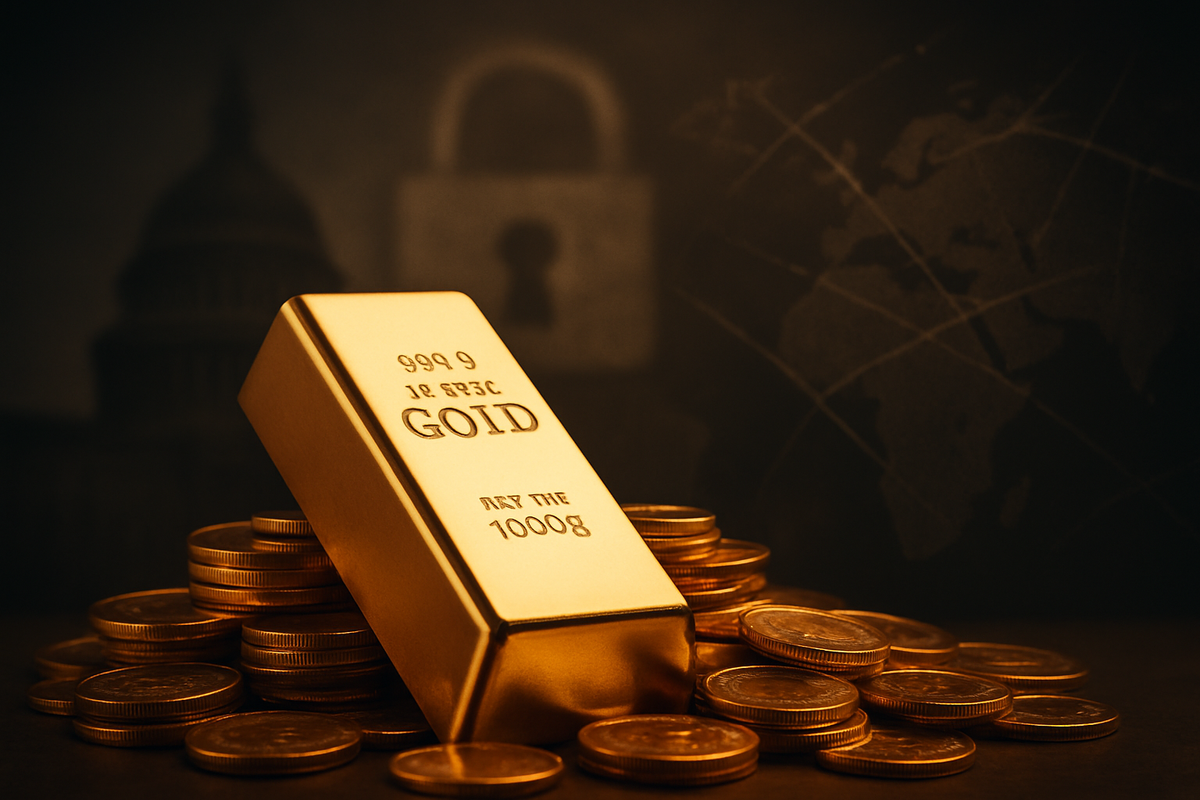
Gold, the perennial safe-haven asset, has once again proven its mettle, surging past the unprecedented $4,000 per ounce mark amidst a volatile global economic landscape. As of November 6, 2025, the precious metal is not merely hovering shy of this psychological barrier but has decisively breached it, with spot prices reported around $4,011.79 per ounce. This remarkable ascent is largely attributed to a potent cocktail of a prolonged U.S. government shutdown, escalating tariff uncertainties, a depreciating U.S. dollar, and a palpable resurgence of investor demand for stability. The implications are immediate and significant: investors are actively de-risking portfolios, shifting capital away from volatile equities and into the perceived safety of gold, signaling deep concerns about the stability of the world's largest economy and global trade relations.
The current market dynamics underscore a profound erosion of confidence in traditional financial instruments and government stability. With the U.S. government embroiled in its longest shutdown in history and the shadow of renewed global trade wars looming large, the appeal of a tangible asset like gold has intensified. This flight to quality is not just a reaction to immediate crises but reflects a deeper anxiety about future economic growth, inflation, and the efficacy of political governance, positioning gold as a critical barometer of global financial health in uncertain times.
Unpacking the Drivers: Shutdown Paralysis, Tariff Tensions, and a Weaker Dollar
The primary catalyst for gold's meteoric rise is an unprecedented U.S. government shutdown, which, as of November 6, 2025, has become the longest in the nation's history, extending well beyond 35 days. This protracted congressional impasse over federal funding has crippled government operations, leading to the furlough of millions of federal employees and the suspension of critical public services. Crucially, the shutdown has halted the release of vital economic data, creating a significant information vacuum that has forced the Federal Reserve and market participants to rely on less comprehensive private-sector indicators for economic assessment. This data scarcity has amplified market uncertainty, compelling investors to seek refuge in gold as a stable store of value amidst a fog of economic unknowns.
Compounding the domestic political turmoil is a renewed wave of global tariff uncertainty. Tensions, reminiscent of earlier trade disputes, have resurfaced as the U.S. Supreme Court initiated hearings on the legality of wide-ranging tariffs previously enacted. The potential outcomes of this landmark case carry significant implications for global supply chains, international trade relations, and inflationary pressures worldwide. Analysts have pointed to developments in this Supreme Court hearing as a direct contributor to the heightened demand for gold, as businesses and investors brace for potential disruptions and increased costs.
Adding further impetus to gold's rally is a notable weakening of the U.S. dollar. The U.S. dollar index has retreated from its recent highs, a development that makes dollar-denominated gold more attractive and affordable for international buyers holding other currencies. This inverse relationship between gold and the dollar is a fundamental market dynamic: as the dollar depreciates, gold's appeal as an alternative currency and store of value typically strengthens. This confluence of a domestic political crisis, international trade fears, and a softer dollar has created a perfect storm, fostering a broad "risk-off" environment where investors are shedding riskier assets in favor of gold's perceived stability. Central banks, particularly those in Asia, have also been observed actively accumulating gold reserves, further solidifying its price and signaling a strategic diversification away from traditional currency reserves in an effort to hedge against dollar volatility and geopolitical risks. As of the reporting date, U.S. gold futures for December delivery also saw gains, reaching $4,021.20 per ounce, reinforcing the strong bullish sentiment.
Corporate Fortunes Diverge: Winners and Losers in a Turbulent Market
The current economic and political headwinds are creating a stark divide in corporate performance, with some sectors poised for significant gains while others face severe challenges.
Gold Miners and Royalty Companies Strike Gold: Unsurprisingly, the most direct beneficiaries of surging gold prices are the publicly traded gold mining companies. Firms like Newmont Corporation (NYSE: NEM), Barrick Gold Corporation (NYSE: GOLD), Agnico Eagle Mines Limited (TSX: AEM), Kinross Gold Corporation (NYSE: KGC), Alamos Gold Inc. (NYSE: AGI), and AngloGold Ashanti PLC (NYSE: AU) are experiencing a significant boost to their revenues and profit margins. Each ounce of gold sold at over $4,000 directly translates to enhanced profitability. This high-price environment also makes previously uneconomical deposits viable, potentially extending mine life and encouraging increased exploration and development budgets. Similarly, royalty and streaming companies such as Franco-Nevada (NYSE: FNV), Wheaton Precious Metals (NYSE: WPM), and Royal Gold (NASDAQ: RGLD) benefit immensely. These companies provide upfront financing to miners in exchange for a percentage of future production or revenue, enjoying the upside of higher gold prices without bearing the direct operational costs and risks of mining.
Government Contractors Face Paralysis: On the losing side, companies heavily reliant on U.S. federal contracts are enduring significant setbacks due to the prolonged government shutdown. Defense giants like Lockheed Martin (NYSE: LMT), RTX Corporation (NYSE: RTX), General Dynamics Corporation (NYSE: GD), Boeing (NYSE: BA), and Northrop Grumman Corporation (NYSE: NOC) face delays in contract awards, modifications, and payments for non-essential projects. While work on critical programs may continue, new orders are frozen, and funding for some ongoing projects is disrupted, impacting their defense revenues and cash flow. Similarly, IT and consulting firms such as Leidos Holdings, Inc. (NYSE: LDOS) and Booz Allen Hamilton (NYSE: BAH), which derive substantial revenue from federal agencies, are grappling with delayed payments, halted projects, and reduced demand for new services. Construction and infrastructure contractors like Fluor Corporation (NYSE: FLR) and Jacobs Solutions Inc. (NYSE: J) are also experiencing frozen activity and potential stop-work orders on federal projects, leading to cash flow issues and increased costs.
Trade-Dependent Companies Grapple with Tariff Uncertainty: Companies with extensive international supply chains and sales are bracing for the fallout from renewed tariff uncertainty. Automotive manufacturers like Ford Motor Company (NYSE: F) and General Motors (NYSE: GM) are particularly vulnerable, as proposed tariffs on imported cars and parts could significantly increase production costs and potentially dampen consumer demand. Retaliatory tariffs from other nations could further harm their export markets. Technology and electronics giants such as Apple Inc. (NASDAQ: AAPL), Intel Corporation (NASDAQ: INTC), Cisco Systems Inc. (NASDAQ: CSCO), and Microsoft (NASDAQ: MSFT), with their complex global manufacturing networks, face increased production costs and potential supply chain disruptions due to tariffs. Industrial and manufacturing firms like Caterpillar Inc. (NYSE: CAT) and General Electric (NYSE: GE), dependent on raw material imports, could see higher input costs and reduced global demand for their capital goods, forcing a re-evaluation of their supply chain strategies and potentially leading to costly reshoring or nearshoring initiatives.
Wider Significance: A Return to Basics Amidst Global Instability
The current gold rally and the underlying economic and political turmoil signify more than just a momentary market fluctuation; they point to a fundamental shift in investor sentiment and broader industry trends. The resurgence of gold as a primary safe-haven asset reflects a global "risk-off" environment, where investors prioritize capital preservation over growth. This trend underscores a growing distrust in traditional financial assets, particularly those tied to government stability and global trade, prompting a return to tangible assets as a hedge against inflation and systemic risk.
This event fits into a broader trend of deglobalization and increased protectionism. The re-emergence of significant tariff debates, coupled with a prolonged U.S. government shutdown, highlights the fragility of interconnected global supply chains and the potential for political decisions to severely disrupt economic activity. Companies are now being forced to re-evaluate their reliance on single-country manufacturing hubs and consider more diversified or localized production strategies, leading to potential inefficiencies and increased costs in the short term. The ripple effects extend beyond direct trade, impacting shipping industries, logistics providers, and even consumer goods prices as companies pass on increased costs.
Regulatory and policy implications are profound. The Federal Reserve, already navigating a complex monetary policy landscape, faces increased pressure to maintain economic stability amidst government paralysis. The shutdown's impact on economic data collection further complicates their decision-making process regarding interest rates and quantitative easing. Furthermore, the political gridlock leading to the shutdown raises questions about the U.S. government's ability to effectively govern and manage its fiscal responsibilities, potentially impacting its credit rating and the global perception of its economic reliability. Historically, government shutdowns, though rarely as prolonged as the current one, have often led to temporary economic slowdowns and increased market volatility, but the sustained nature of this event, coupled with trade tensions, makes it a more significant concern than previous precedents. This situation draws parallels to periods of heightened geopolitical instability or major financial crises where gold's role as a hedge against uncertainty became paramount.
What Comes Next: Navigating a Landscape of Uncertainty
The immediate future remains clouded by the ongoing U.S. government shutdown and the unresolved tariff disputes, suggesting continued volatility and a sustained appetite for safe-haven assets. In the short term, gold prices are likely to remain elevated, with some analysts forecasting the possibility of gold reaching $4,200 per ounce by year-end if the Federal Reserve continues with expected rate cuts. Should geopolitical turbulence and domestic political paralysis persist, more aggressive predictions of $4,500 to $4,700 per ounce in the coming year are not out of the question.
Companies, particularly those impacted by government contracts and international trade, will need to implement significant strategic pivots. Government contractors may need to diversify their client base, reduce reliance on federal funding, and build stronger cash reserves to weather future shutdowns. For multinational corporations, adapting to tariff uncertainty will involve re-evaluating supply chain resilience, exploring alternative sourcing locations, or even considering reshoring production to mitigate trade risks. This could lead to a strategic shift towards more regionalized supply chains, potentially increasing operational costs in the short term but offering greater stability against future trade disputes.
Market opportunities may emerge for companies specializing in supply chain resilience, automation, and domestic manufacturing solutions. Investors will continue to seek out assets that offer stability and inflation hedging, with gold remaining a prime candidate. The challenges, however, are substantial: prolonged economic uncertainty could dampen consumer spending, stifle investment, and potentially lead to a broader economic slowdown. The risk of a recession, exacerbated by government inaction and trade wars, remains a significant concern. Potential scenarios range from a swift resolution of the shutdown and trade disputes leading to a market rebound, to a protracted period of instability that fundamentally alters global economic structures and investment patterns.
A New Era for Gold: Enduring Significance in a Fractured World
The current surge in gold prices, driven by the confluence of a prolonged U.S. government shutdown and escalating tariff uncertainty, underscores a critical shift in global financial markets. The precious metal's ascent past the $4,000 per ounce threshold is not merely a transient reaction to immediate crises but a profound indicator of deep-seated anxieties regarding political stability, economic predictability, and the efficacy of global trade mechanisms. Key takeaways from this event include gold's undeniable reaffirmation as the ultimate safe-haven asset, the severe economic ramifications of political gridlock, and the pervasive fear of a return to protectionist trade policies.
Moving forward, the market is likely to remain highly sensitive to developments on both the domestic political front and international trade negotiations. The duration and eventual resolution of the U.S. government shutdown will be a critical determinant of short-term market sentiment, as will any progress or escalation in tariff disputes. Investors should brace for continued volatility and a sustained flight to quality as long as these uncertainties persist.
The lasting impact of this period could be a more permanent shift in investment strategies, with a greater emphasis on diversification into tangible assets and a reduced appetite for risk in traditional equity markets. What investors should watch for in the coming months includes any signs of a political resolution in Washington, D.C., concrete developments from the Supreme Court's tariff hearings, and the Federal Reserve's response to ongoing economic data challenges. Furthermore, monitoring central bank gold purchasing trends and the U.S. dollar's performance will provide crucial insights into gold's continued trajectory and the broader health of the global economy. This period marks a historic milestone for gold, cementing its enduring significance in a world increasingly characterized by economic and geopolitical fragmentation.
This content is intended for informational purposes only and is not financial advice




